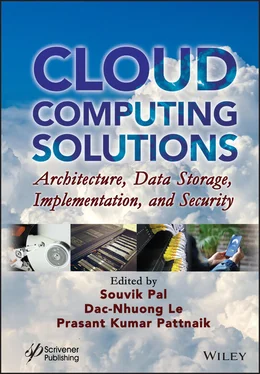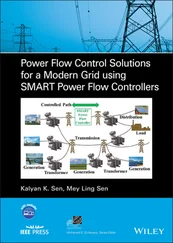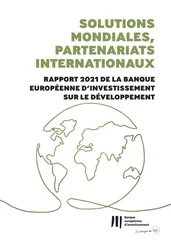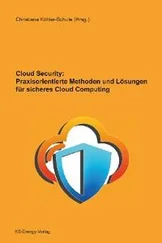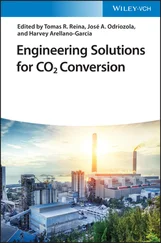Cloud Computing Solutions
Здесь есть возможность читать онлайн «Cloud Computing Solutions» — ознакомительный отрывок электронной книги совершенно бесплатно, а после прочтения отрывка купить полную версию. В некоторых случаях можно слушать аудио, скачать через торрент в формате fb2 и присутствует краткое содержание. Жанр: unrecognised, на английском языке. Описание произведения, (предисловие) а так же отзывы посетителей доступны на портале библиотеки ЛибКат.
- Название:Cloud Computing Solutions
- Автор:
- Жанр:
- Год:неизвестен
- ISBN:нет данных
- Рейтинг книги:3 / 5. Голосов: 1
-
Избранное:Добавить в избранное
- Отзывы:
-
Ваша оценка:
- 60
- 1
- 2
- 3
- 4
- 5
Cloud Computing Solutions: краткое содержание, описание и аннотация
Предлагаем к чтению аннотацию, описание, краткое содержание или предисловие (зависит от того, что написал сам автор книги «Cloud Computing Solutions»). Если вы не нашли необходимую информацию о книге — напишите в комментариях, мы постараемся отыскать её.
The main purpose of this book is to include all the cloud-related technologies in a single platform, so that researchers, academicians, postgraduate students, and those in the industry can easily understand the cloud-based ecosystems.
Audience
Cloud Computing Solutions — читать онлайн ознакомительный отрывок
Ниже представлен текст книги, разбитый по страницам. Система сохранения места последней прочитанной страницы, позволяет с удобством читать онлайн бесплатно книгу «Cloud Computing Solutions», без необходимости каждый раз заново искать на чём Вы остановились. Поставьте закладку, и сможете в любой момент перейти на страницу, на которой закончили чтение.
Интервал:
Закладка:
Rummler and Brache [17] use a definition that clearly encompasses a focus on the organization’s external customers, when stating that
“A business process is a series of steps designed to produce a product or service. Most processes (...) are cross-functional, spanning the ‘white space’ between the boxes on the organization chart. Some processes result in a product or service that is received by an organization’s external customer. We call these primary processes. Other processes produce products that are invisible to the external customer but essential to the effective management of the business. We call these support processes.”
Following are the basic functionalities that support the workflow system:
Build-time functions are concerned with defining, and possibly modeling, the workflow process and its constituent activities.
Run-time control functions are concerned with managing the workflow processes in an operational environment and sequencing the various activities to be handled as part of each process.
Run-time concerns interactions with human users and IT application tools for processing the various activity steps.
3.4 Examples of Workflow Tools
Various tools are used for the workflows in cloud computing environment. In their paper, Monika Bharti and Anju Bala [15] elaborately describe different workflow tools and their respective operating system, the language they are written in, year of release, developer of the tools, description of the tools, architectural style, database used, and respective companies [16-25].
Table 3.1: Workflow tools in cloud computing.
| Tool | Language | Year | Link |
| UGENE | C++, QtScript | 12/2011 | ugene.net |
| Bonita Open Solution | Java | 01/2011 | www.bonitasoft.com |
| Google App Engine | Python, APIs, URL fetch | 2008 | cloud.google.com/appengine |
| OrangeScape | Java | 2003 | www.orangescape.com/ |
| Kaavo | Java, PHP | 2007 | kaavo.com.cutestat.com/ |
| Oozie | hpdl | 2006 | oozie.apache.org/ |
| Pegasus | Java, Perl, Python | 2003 | www.pegasuscloud.cf/ |
| YAWL | XML, XPath and XQuery | 2002 | www.yaug.org |
UGENE: It is a free open-source cross-platform bioinformatics software, which integrates a number of biological tools and algorithms, and provides both graphical user and command line interfaces. It was developed by UniPro in December 2011. Operating system used is cross-platform, C++ and QtScript is used in language background, it is based on client-server architecture and database used in UGENE is NCBI, PDB, UniProtKB/Swiss-Prot.
Bonita Open Solution: The French National Institute for Research in Computer Science developed the Bonita Open Solution in January, 2011. The business processes can be graphically modified using Bonita Studio. The processes can also be connected to other pieces of the information system to generate an autonomous business application accessible as a web form. It creates high-tech workflows and spreadsheets. Like UGENE, cross platform is used and Java is the developing language. It is based on client-server architecture and ERP, ECM database is used.
Google App Engine: Google developed Google App Engine in 2008, which allows the users to run web application. It is also in client-server pattern and the database used in App Engine is Python or Java. Windows OS is used and Python, APIs, and UrlFetch are used as languages.
OrangeScape: It is an India-based software development company with its headquarters in Chennai, India. It was founded by Suresh Sambandam, who currently serves as chief executive officer at OrangeScape. In 2002, it was named the prime technology partner for Google App Engine.
Kaavo: It provides a framework to mechanize the deployment and run-time management of applications and workloads on multiple clouds. It takes a top-down application-centric approach for deploying and managing applications in the cloud.
Oozie: It is a Java web application that runs in a Java servlet container. Oozie workflow is a collection of actions arranged in a control dependency DAG (direct acrylic graph), specifying a sequence of actions execution, specified in hPDL (a XML process definition language).
Pegasus: Ewa Deelman developed Pegasus in 2003, which is based on client-server architecture. It translates complex computational tasks into workflows. Operating system used is Linux and Windows and language used is Java, Perl, and Python.
YAWL: A new workflow language called YAWL (Yet Another Workflow Language) offers comprehensive support for the control-flow patterns and has a proper formal foundation. It also has unique support for dynamic workflow through the worklet approach. Workflows can thus develop over time to meet new and changing requirements.
3.5 Summary
This chapter has presented the architecture of cloud computing. Cloud computing architectures are essentially subdivided into cloud platform architecture (CPA) and cloud application architecture (CAA), which are linked via the cloud services available on the IT utility marketplace. This chapter also discussed the SOA concept, life cycle of SOA and integration with cloud computing. Fundamentals of the workflow concept were also presented and some workflow tools were discussed at the end of the chapter.
EXERCISES
1 Discuss the framework of cloud computing environment with suitable schematic diagram.
2 What is service-oriented architecture? Explain its characteristics.
3 State and explain the life cycle of service-oriented architecture.
4 What is workflow? How does it coordinate multiple activities in cloud computing environment?
5 Discuss the importance of workflow and state at least one work tool and its working principle.
6 Discuss the challenges of cloud computing environment.
7 What are the various reasons for cloud computing using a stateless server?
8 Provide a real-time example where SOA and cloud computing work together.
9 What is black-box component in SOA?
10 How is the SOA and the cloud integrated and state its workflow principle.
11 Explain different types of hypervisors.
12 Explain network, compute and storage virtualization.
13 What is broker service? Explain different types of broker service.
14 What is distributed resources of physical host?
15 Explain the role of virtual appliance.
16 What are the differences between cloud platform architecture (CPA) and cloud application architecture (CAA)?
17 “Workflow is defined in different ways.” Justify.
18 What is the usage of utility computing?
19 What are the security benefits of cloud computing?
20 What are the open source cloud computing platform databases?
References
1. Hall, J. A., & Liedtka, S. L. (2007). The Sarbanes-Oxley Act: implications for large-scale IT outsourcing. Communications of the ACM, 50(3), 95-100.
2. Buyya, R., Yeo, C. S., & Venugopal, S. (2008, September). Market-oriented cloud computing: Vision, hype, and reality for delivering it services as computing utilities. In 2008 10th IEEE International Conference on High Performance Computing and Communications (pp. 5-13). Ieee.
3. Pal, S., & Pattnaik, P. K. (2012). Efficient architectural framework for cloud computing. International Journal of Cloud Computing and Services Science, 1(2), 66.
Читать дальшеИнтервал:
Закладка:
Похожие книги на «Cloud Computing Solutions»
Представляем Вашему вниманию похожие книги на «Cloud Computing Solutions» списком для выбора. Мы отобрали схожую по названию и смыслу литературу в надежде предоставить читателям больше вариантов отыскать новые, интересные, ещё непрочитанные произведения.
Обсуждение, отзывы о книге «Cloud Computing Solutions» и просто собственные мнения читателей. Оставьте ваши комментарии, напишите, что Вы думаете о произведении, его смысле или главных героях. Укажите что конкретно понравилось, а что нет, и почему Вы так считаете.
